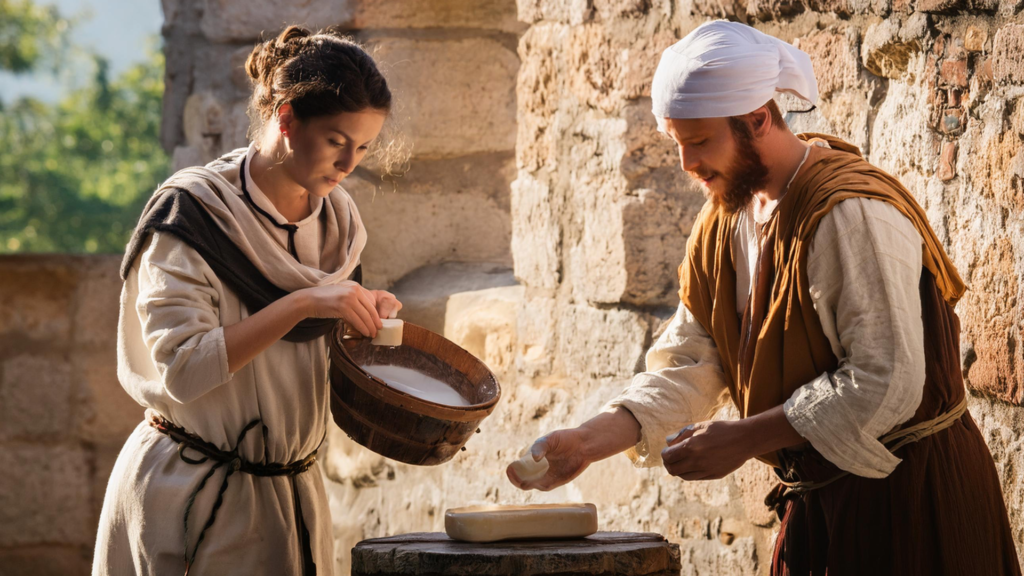Here we’re going to explore how to make soap and its history.
Soap is a ubiquitous substance that plays a crucial role in personal hygiene and cleaning. Its creation methods and production have evolved significantly over time, reflecting advancements in chemistry and changes in societal needs.
This article first explores the history of soap, its early and modern production methods. Next, the basics of how to make soap are addressed.

Origins and Early History of Soap
The origins of soap date back to ancient civilizations, with evidence suggesting that soap-making began around 2800 BCE. The earliest records come from the Babylonians, who were among the first to develop a method of soap production. They combined animal fats with wood ashes, a process that involved heating the mixture to create a crude form of soap.

In ancient Egypt, soap was used primarily for washing textiles rather than personal hygiene. The Egyptians made a soap-like substance from animal and vegetable oils mixed with alkaline salts. They also documented their methods in the Ebers Papyrus, an ancient Egyptian medical text.
The Romans further refined soap-making techniques. They improved the formula by using lye (a strong alkaline solution) derived from wood ashes and animal fats. Roman baths were equipped with soap-making facilities, and soap was used for both personal cleanliness and medical purposes.
In medieval Europe, soap production became more widespread, although it was often a cottage industry. The process involved mixing fats with ashes from burned wood. By the 16th century, soap-making had become an established craft, with soap production regulated by laws in several countries to ensure quality and fairness.

The Science of Soap
The science of soap revolves around the principles of chemistry and physics. Soap is a surfactant, which means it lowers the surface tension of water, allowing it to more effectively penetrate and remove dirt and oil. The key to soap’s effectiveness lies in its molecular structure.

Molecular Structure
Soap molecules have a dual nature. One end of the molecule is hydrophilic (water-attracting) and the other is hydrophobic (water-repelling). The hydrophilic end is attracted to water, while the hydrophobic end is attracted to oils and fats. When soap is added to water, the soap molecules arrange themselves into structures called micelles.
In a micelle, the hydrophobic tails of the soap molecules cluster together in the center, while the hydrophilic heads face outward toward the water. This arrangement allows the soap to surround and lift away oil and grease, which can then be rinsed away with water.
Traditional Soap-Making Methods
Traditional soap-making methods involve a chemical reaction known as saponification. Saponification occurs when fats or oils are combined with a strong base, typically lye (sodium hydroxide). The reaction produces soap and glycerin.
Ingredients
1. Fats and Oils: Traditionally, animal fats (such as tallow) or vegetable oils (such as olive oil) were used. These fats are composed of triglycerides, which are molecules made up of fatty acids and glycerol.
2. Lye (Sodium Hydroxide): Lye is a caustic substance that acts as the alkaline component in the saponification reaction. It is essential for breaking down the fats into soap.
3. Water: Water is used to dissolve the lye and facilitate the saponification reaction.
4. Additives: Traditional soap-makers often added natural fragrances, colorants, or herbal extracts for additional properties or aesthetics.

Modern Soap Production
The production of soap has advanced significantly since ancient times. Modern soap-making processes are more controlled and efficient, using both traditional and innovative techniques. There are two primary methods used in contemporary soap production: the cold process and the hot process.
Cold Process Soap-Making
The cold process method involves mixing fats or oils with a lye solution at room temperature. The mixture is stirred until it reaches “trace,” a stage where it thickens and leaves a trail when drizzled on the surface. Essential oils, fragrances, and colorants can be added at this stage. The soap is then poured into molds and allowed to cure for several weeks.
Ingredients:
1. Fats and Oils: Modern soap-makers use a variety of oils, including coconut oil, palm oil, and shea butter. Each type of oil contributes different properties to the final product.
2. Lye (Sodium Hydroxide): As with traditional methods, lye is used to saponify the fats.
3. Water: Water is used to dissolve the lye.
4. Additives: Modern soap-makers often use synthetic fragrances, colorants, and preservatives. Natural alternatives, such as essential oils and clay, are also popular.

Hot Process Soap-Making
The hot process method involves heating the soap mixture to accelerate saponification. This method can produce soap more quickly than the cold process, as the soap is fully cooked and does not require a lengthy curing period. The hot process method is often used in commercial soap production.
Ingredients:
1. Fats and Oils: Similar to the cold process, but the mixture is cooked to speed up the reaction.
2. Lye (Sodium Hydroxide): Used in the same way as in the cold process.
3. Water: Used to dissolve the lye.
4. Additives: Essential oils, colorants, and other additives can be incorporated after the cooking process.

The Modern Industry
In the modern soap industry, there are numerous formulations and applications for soap. Industrial soap production often uses automated processes and may include additional ingredients such as synthetic surfactants, moisturizers, and antibacterial agents. The emphasis is on consistency, efficiency, and meeting specific market demands.

Common Ingredients in Commercial Soap:
*some believe in avoiding synthetic ingredients, it’s important to research products to know if an ingredient is right for you.
1. Surfactants: Synthetic surfactants, such as sodium lauryl sulfate, may be used alongside or instead of traditional soap ingredients.
2. Moisturizers: Ingredients like glycerin or shea butter are added to prevent skin dryness.
3. Antibacterial Agents: Ingredients like triclosan or essential oils with antimicrobial properties are included in some formulations.
4. Colorants and Fragrances: Synthetic dyes and fragrances are used to enhance the product’s appearance and scent.

Soap, a fundamental component of cleanliness and hygiene, has been with humans through several millennia of history. It’s impact has been significant in various cultures and societies over time. From its ancient origins to modern production methods, the science of soap has evolved to meet changing needs and technologies.
Whether through traditional methods or contemporary innovations, the core principles of soap-making remain rooted in the chemistry of saponification and the quest for effective and safe cleaning solutions. As we continue to advance, the science and art of soap-making will likely adapt, blending tradition with modernity to serve both practical and aesthetic purposes.